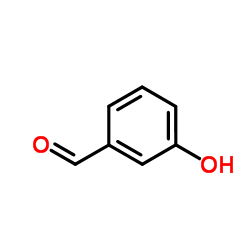3-Hydroxybenzaldehyde

3-Hydroxybenzaldehyde structure
|
Common Name | 3-Hydroxybenzaldehyde | ||
|---|---|---|---|---|
| CAS Number | 100-83-4 | Molecular Weight | 122.121 | |
| Density | 1.2±0.1 g/cm3 | Boiling Point | 240.9±13.0 °C at 760 mmHg | |
| Molecular Formula | C7H6O2 | Melting Point | 100-103 °C(lit.) | |
| MSDS | Chinese USA | Flash Point | 98.6±12.4 °C | |
| Symbol |

GHS07 |
Signal Word | Warning | |
|
3D-QSAR and molecular docking studies of benzaldehyde thiosemicarbazone, benzaldehyde, benzoic acid, and their derivatives as phenoloxidase inhibitors.
Bioorg. Med. Chem. 15 , 2006-15, (2007) Phenoloxidase (PO), also known as tyrosinase, is a key enzyme in insect development, responsible for catalyzing the hydroxylation of tyrosine into o-diphenols and the oxidation of o-diphenols into o-quinones. Inhibition of PO may provide a basis for novel env... |
|
|
A chemical screening approach reveals that indole fluorescence is quenched by pre-fibrillar but not fibrillar amyloid-beta.
Bioorg. Med. Chem. Lett. 19 , 4952-7, (2009) Aggregated amyloid-beta (Abeta) peptide is implicated in the pathology of Alzheimer's disease. In vitro and in vivo, these aggregates are found in a variety of morphologies, including globular oligomers and linear fibrils, which possess distinct biological ac... |
|
|
Mass spectrometric behavior of phenolic acids standards and their analysis in the plant samples with LC/ESI/MS system.
J. Chromatogr. B. Analyt. Technol. Biomed. Life Sci. 967 , 21-7, (2014) Liquid chromatography coupled to mass spectrometry (MS) with electrospray ionization (ESI) is one of analytical techniques to obtain accurate results of low molecular weight aromatic compounds in biological samples of different origin. The interpretations of ... |
|
|
Hydrogen bond, dimerization and vibrational modes in 2-chloro-3-hydroxybenzaldehyde and 3-chloro-4-hydroxybenzaldehyde from vibrational and ab initio studies.
Spectrochim. Acta. A. Mol. Biomol. Spectrosc. 77(5) , 1025-33, (2010) Ab initio conformers and dimers have been computed at RHF and B3LYP/6-31G* levels for isomers 2-chloro-3-hydroxybenzaldehyde and 3-chloro-4-hydroxybenzaldehyde to explain the observed infrared absorption and Raman vibrational spectral features in the region 3... |
|
|
Asymmetric total synthesis of (-)-quinocarcin.
J. Am. Chem. Soc. 130(22) , 7148-52, (2008) (-)-Quinocarcin (1) has been synthesized in a longest linear sequence of 22 steps from 3-hydroxybenzaldehyde in 16% overall yield. The Pictet-Spengler reaction of L-tert-butyl-2-bromo-5-hydroxy phenylalanate (17), synthesized according to Corey-Lygo's enantio... |
|
|
Growth and characterization of organic material 3-hydroxybenzaldehyde single crystal by modified vertical Bridgman technique.
Spectrochim. Acta. A. Mol. Biomol. Spectrosc. 87 , 194-8, (2012) Novel organic nonlinear optical (NLO) material 3-hydroxybenzaldehyde (3HBA) single crystals have been grown by modified vertical Bridgman technique using the single and double wall ampoules with nano translation. Single crystal X-ray diffraction analysis reve... |
|
|
IR spectral and structural changes caused by the conversion of 3-hydroxybenzaldehyde into the oxyanion.
Spectrochim. Acta. A. Mol. Biomol. Spectrosc. 59(7) , 1541-8, (2003) The spectral and structural changes, caused by the conversion of the 3-hydroxybenzaldehyde molecule into the corresponding oxyanion have been studied by IR spectra, and MP2 and DFT force field calculations. The conversion causes a 13 cm(-1) decrease in the fr... |
|
|
Bidirectional transformation of aromatic aldehydes by Desulfovibrio desulfuricans under nitrate-dissimilating conditions.
Lett. Appl. Microbiol. 22(2) , 115-20, (1996) Desulfovibrio desulfuricans ATCC 27774 was screened for reactivity against aromatic compounds during lactate-dependent, nitrate-dissimilating growth. Only aromatic aldehydes (benzaldehyde, 2-hydroxybenzaldehyde, 3-hydroxybenzaldehyde, 4-hydroxybenzaldehyde, v... |